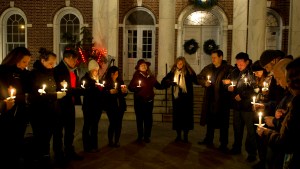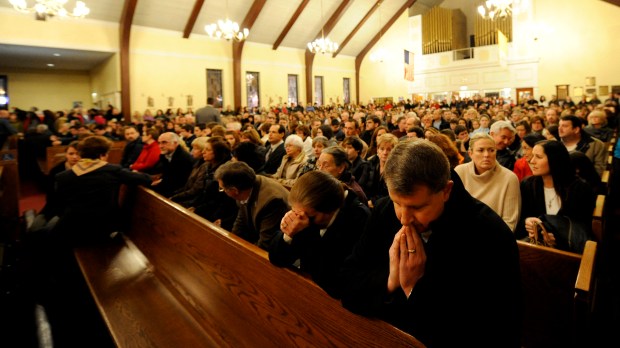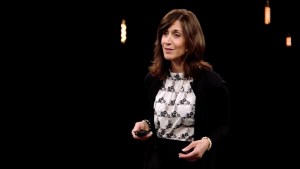Lenten Campaign 2025
This content is free of charge, as are all our articles.
Support us with a donation that is tax-deductible and enable us to continue to reach millions of readers.
Two days after a gunman took the lives of 20 school children in Newtown, Connecticut, Msgr. Robert Weiss took to the pulpit of St. Rose of Lima church there to help his parishioners make sense of the tragedy. Eight of those children were members of St. Rose parish, and Msgr. Weiss and his associate pastors looked ahead to a week of heart-wrenching funerals.
“We can put in all the security doors we want, we can put on duty all the police we want, but things like this can still happen,” he said at the end of Sunday Mass. “But if we change this world from a culture of death, which it’s quickly becoming, to a culture of life, then we don’t have to be afraid.”
In an interview with Aleteia a year later, he hit on a similar theme: “I’ve always felt that until all of us embrace life and embrace the respect each person deserves, all the legislation in the world is not going to help us,” he said. “We really need to adopt an attitude about life, and our new Holy Father [Pope Francis] is really helping us to do that. I’m still very hopeful.”
10 Years later …
Ten years after the massacre at Sandy Hook Elementary School, a new culture of life still needs to be built.
The Sandy Hook massacre was international news, certainly due to its very high death toll, but also because school shootings were not all that common then. Sadly, Sandy Hook has become one in a long list of mass shootings since then. Many are soon forgotten because the phenomenon has become so frequent.
A culture of life, it would seem, is still a long ways off.
Even the U.S. Supreme Court decision this summer overturning Roe v. Wade, a result long hoped for by the pro-life movement, envisioned by some as a key milestone on restoring a culture of life to American society, did not give Msgr. Weiss much hope.
“To be honest, I saw the reaction to the Supreme Court decision on Roe v. Wade, and I realized to myself that, ‘I don’t know where anybody’s heads are anymore.’ Not to get into the politics of all that, but I just realized where we are as a society, how we value life and what we see life to be …” he said in an interview last week, his words trailing off. “But it certainly is discouraging to see the absolute disregard for life.”
The reaction to the Dobbs v. Jackson ruling of June 24 was in many ways a hardening of the lines dividing Americans over the issue of abortion. While some states proceeded to ban the procedure, abortion advocates continue fighting hard to protect what they consider to be a woman’s right to end the life of her unborn child.
He added that the influence that a general “culture of death” is having on young people is frightening to him. “I think they just assume that that’s what life is,” he said. “They don’t know what it’s like to live in a time when people respected each other.”
Lockdown
On December 14, 2012, Msgr. Weiss had been at St. Rose for 14 years when a gunman’s actions brought a war-zone-like atmosphere to the quiet New England town. Twenty-year-old Adam Lanza killed his mother in their home that morning, then drove to the Sandy Hook Elementary School and killed 20 first-graders – all between the ages of six and seven – and six teachers and administrators. In the end, he turned the gun on himself.
St. Rose, a large and very active parish less than 50 miles southwest of Hartford, the state capital, had an elementary school of its own and a flourishing religious education program. Hearing the news of the shooting, Msgr. Weiss went to the church to inform the priest who was celebrating morning Mass that all area schools were being put on lockdown. He then rushed to the Sandy Hook school and stayed all day at a local firehouse, where officials were bringing students to be reunited with their parents.
He spent much of that afternoon comforting families that would not be reunited with the children they dropped off at school that morning. He would learn in time that eight of the dead were children of his own parish – making St. Rose the site of more funerals in Newtown than any other house of worship.
That evening, hundreds of people gathered at the church for prayer and consolation.
A season of joy
It was Advent, and the first Sunday after the shooting was Gaudete Sunday, when a pink Advent candle would burn and priests would wear rose vestments – symbols of the joyful anticipation of the Messiah. All that was dispersed by the “heaviness,” as Msgr. Weiss put it, that pervaded the atmosphere.
But he insisted that Christmas lights not be turned off, as the deceased children had so looked forward to the feast. One of the girls who was murdered, Olvia Rose Engel, 6, had been set to portray an angel in the parish Christmas pageant on Christmas Eve. In time, the parish would dedicate a sculpture called The Angel of Hope, as well as a bell that was struck in honor of the victims, inscribed with words from the Gospel of St. John: “The light shines in the darkness, but the darkness did not overcome it.”
Asked about what has sustained him throughout the difficult ordeal and over the past 10 years, Msgr. Weiss said that he has been “really proud of this parish community.”
“When this happened, nobody was prepared for it. But just to watch this community that we had been working to form come together was really just such a blessing,” he said. “People were just here. I think presence was the most important aspect of what we could do for these families. [As the community came together at the church,] some of our parishioners were in the parking lot with boxes of Kleenex and bottles of water.
“While people were waiting in line during the wake they were bringing hot coffee and letting them talk and console them.
“If you weren’t here it’s hard to explain this, but to walk out onto Church Hill Road and see the street lined with hundreds of police officers for a funeral, and the next day it was hundreds of firefighters. For one there was a motorcycle contingent. Every time we had a funeral it had a different complexion to it, and all of the security, the safety, even though we had professionals, was really organized by our own parishioners. We had people in the rectory 24/7 answering phone calls, checking emails, and receiving messages. It was non-stop.”
“So, certainly, I was proud of how we had formed ourselves as a community and were so present to each other during this time,” the pastor said.
Msgr. Weiss’s tenure has been unusually long for a pastor, normally limited to two six-year terms. At 76, a year past the normal retirement age for diocesan priests, he asked his bishop for permission to stay on for the 10th anniversary of the shooting and to be able to celebrate his 50th anniversary of ordination next year at St. Rose.
After that, he hopes to stay in the area and be of whatever assistance he can be.
“I think I’ve done what I can do, and I’ve loved it here. But certainly, I’m going to step back,” he said. “Physically, I hope I can keep going, but this is a very large parish. It takes a lot.”



